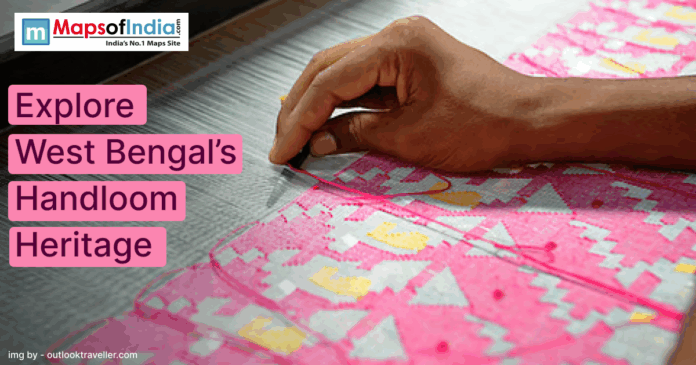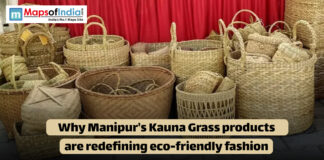The handloom things are made across the various regions of India. Many parts of India are really well known for their handloom works. One of them is that the state is West Bengal. In this state, various parts are creating a handloom that is as rich in heritage as it is diverse, in showing the artistic talent of the artist of their state and showing the richness of their culture. The state’s weavers have maintained ancient techniques coupled with contemporary needs. This industry has been going on for many years and has sustained through various differences and shifts happening in the state of West Bengal.
Historical Development of Handloom in Bengal
The handloom heritage of Bengal goes back to ancient days when fine Bengal muslin was valued all over the globe. India was under the Mughal rule when Bengal muslin and silk cloth that were prepared across India were being exported to Europe, Asia, and the Middle East countries. During the colonial period, this industry started to thrive in that area more. But as time goes on, it has seen a decline in many areas, but is sustaining in towns and small villages. With independence for India, Bengal’s handloom industry came back to life as cooperatives and government programs. Weavers re-learned traditional techniques to suit changed markets, with the dignity of their craft remaining intact.
The Diversity of Bengal’s Weaves
Bengal’s handloom heritage is diverse. Each area has its own style determined by local traditions and the availability of materials. Dhaka and Nadia’s Jamdani fabric has subtle flower motifs, and Baluchari sarees of Bishnupur have mythological stories woven into filigree designs. Sarees made in Santipur, known as the Tangail sarees, which are famous for being light and sophisticated, have striped borders. Begumpuri and Dhaniakhali weaves are plain and for everyday wear. These regional differences lend Bengal’s handloom its distinctiveness.
Jamdani: The Fine Art of Weaving Dreams
Jamdani is Bengal’s most famous handloom tradition. Jamdani is a Persian word for “flower” and “vase.” Jamdani is woven with fine cotton yarns that create delicate designs directly on the loom. It is a very patient and skilful process in which the motifs are inserted by hand with an extra weft method. Jamdani was originally woven white on white, but now it contains multi-colored motifs on pale pastel backgrounds. The sarees are light, airy, and may take weeks or months to make. Jamdani is now a globally recognized UNESCO Intangible Cultural Heritage.
Baluchari: The Mythological Tale-Spinning Saree of Bishnupur
Baluchari sarees of Bishnupur town are famous for containing intricate mythological and folk motifs. Borders and pallus frequently have scenes from the Mahabharata and Ramayana covered in silk threads. It began in the 18th century when Murshidabad weavers migrated to Bishnupur due to floods. The application of rich colours and motifs embroidered on pure silk lends Baluchari sarees the royal allure. Contemporary weavers play with modern themes and green dyes to ensure that this heritage survives. Baluchari symbolizes the narrative spirit of Bengal textile art.
Tangail and Santipur Weaves
Tangail sarees originated in Tangail in present-day Bangladesh, but the craft of weaving flourished in Nadia and Santipur following Partition. The silky texture and distinctive borders are the hallmarks of Tangail sarees. The sarees are made of fine cotton threads, which make them light in weight and airy, suitable for Bengal’s climate. The typical motifs include geometric patterns and small buti motifs throughout the body. The Tangail saree is typically employed for festive and casual wear as well. Santipur weavers have carried the designs to a cotton-silk blend appealing to younger customers.
Dhaniakhali and Begumpuri: Daily Chic
The sarees that are prepared in the region of Hooghly and Burdwan, and are known as the Dhaniakhali and Begumpuri, are really well known for their longevity and affordability. These sarees are typically crafted from coarse cotton with plain borders and stripes. The weavers adopt pit looms along with ancient hand techniques. Dhaniakhali sarees can easily be recognized by their extensive borders and check designs. Begumpuri sarees possess a lightweight framework with temple borders or plain stripes. These weaves are for everyday use and are well-liked for their comfort and aesthetics. Their popularity shows how deeply Bengal’s handloom is woven into everyday life without any loss of style.
Women in Weaving Traditions
Women are also important in Bengal’s handloom culture. Women assist in yarn-dyeing, thread preparation, and in the fixing of the looms in the majority of weaving societies. Some women are also independent weavers producing high-value textiles from home. Handloom production provides rural women with flexible employment as well as adds to family incomes. It also ensures intergenerational knowledge since daughters are taught to weave by their mothers. The advent of women’s cooperatives has allowed many craftsmen to turn into entrepreneurs, augmenting self-reliance along with craftsmanship.
Global Presence of Bengal Handloom
West Bengal’s handloom goods have acquired markets outside India. Jamdani Baluchari and Tangail sarees are shipped to European countries, Japan, and the United States. Fashion designers across the world have used Bengal’s fabrics in fashion garments. Global interest in sustainable handcrafted fabric has additionally driven demand. Bengal sarees are now sold through various online platforms, directly linking artisans with overseas customers. Global popularity of the craft is in its fusion of high-quality cultural foundations and sustainable production.
Challenges and the Path Forward
Bengal’s handloom sector, despite its heritage, is faced with a series of problems. The weavers are challenged with rising raw material costs, power loom competition, and curtailed access to credit. Younger generations do not prefer to take up the craft because of low income. Branding and marketing continue to be weak in most rural zones. In these various challenges, there are different digital platforms that form design partnerships that are helping in creating various possibilities. There are various skill development and fair trade initiatives that are started by the government, and at the same time, different private sectors are revitalizing interest among artisans. There are various ways that encouragement is given to the artist to keep Bengal’s handloom sector to keep flourishing. And the fusing of tradition and innovation keeps going.
Conclusion
West Bengal’s handloom heritage is a tale of resilience, creativity, and cultural pride. Every Jamdani weave to Baluchari has a story to tell of artistry handed down through the ages. Through this craft, we can see that the spirit of Bengal is being kept alive. In various parts of Bengal, we can see the blend of tradition and innovation. Through this craftsmanship, they are trying to honour the long-standing heritage of Bengal not only via cloth but the cultural cloth of a people that has spun dreams into yarn for centuries.





